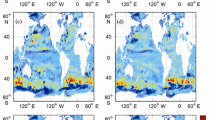Abstract
A study is performed of the spatiotemporal variability of the parameters of the Nucleus Model of Ocean Circulation for European Modeling of the Ocean (NEMO) with data assimilated by a generalized Kalman filter (GKF) described earlier by the authors. A fundamentally new approach based on the theory of stochastic differential equations is proposed to determine key GKF parameters. It is shown how these parameters influence the calculations of the model. This approach does not require preliminary construction of the ensemble of model states or assume the model is unbiased (with no systemic error) in regard to observations. The proposed approach allows the asymptotic behavior of model parameters to be obtained, particularly estimates of the probability they will not exceed some fixed level in the considered time interval of modeling. The spatiotemporal variability of ocean parameters is modeled with NEMO using the proposed data assimilation and observations from the Argo archive. Numerical calculations are made on the K-60 supercomputer at the Russian Academy of Sciences’ Keldysh Institute of Applied Mathematics.


Similar content being viewed by others
REFERENCES
K. P. Belyaev and V. N. Solov’ev, ‘‘The numerical calculations of the thermohydrodynamic eguations for the ocean current model in the subpolar frontal zone of North Atlantic,’’ Mat. Model. 8 (11), 87–95 (1996).
G. I. Marchuk and V. B. Zalesny, ‘‘Modeling of the World Ocean circulation with the four-dimensional assimilation of temperature and salinity fields,’’ Izv. Atmos. Ocean. Phys. 48 (1), 15–29 (2012). https://doi.org/10.1134/S0001433812010070
R. Tardiff, G. J. Hakim, and C. Snider, ‘‘Coupled atmosphere–ocean assimilation experiments with a low-order climate model,’’ Clim. Dyn. 43, 1631–1643 (2014). https://doi.org/10.1007/s00382-013-1989-0
C. A. S. Tanajura and K. Belyaev, ‘‘A sequential data assimilation method based on the properties of a diffusion-type process,’’ Appl. Math. Modell. 33 (5), 2165–2174 (2009). https://doi.org/10.1016/j.apm.2008.05.021
K. Belyaev, A. Kuleshov, N. Tuchkova, and C. A. S. Tanajura, ‘‘An optimal data assimilation method and its application to the numerical simulation of the ocean dynamics,’’ Math. Comp. Modell. Dyn. Syst. 24 (1), 12–25 (2018). https://doi.org/10.1080/13873954.2017.1338300
K. Belyaev, A. Kuleshov, and I. Smirnov, ‘‘Spatial–temporal variability of the calculated characteristics of the ocean in the Arctic Zone of Russia by using the NEMO model with altimetry data assimilation,’’ J. Mar. Sci. Eng. 8 (10), 753 (2020). https://doi.org/10.3390/jmse8100753
K. Belyaev, A. Kuleshov, I. Smirnov, and C. A. S. Tanajura, ‘‘Generalized Kalman filter and Ensemble Optimal Interpolation, their comparison and application to the Hybrid Coordinate Ocean Model,’’ Mathematics 9 (19), 2371 (2021). https://doi.org/10.3390/math9192371
I. I. Gikhman and A. V. Skorokhod, Introduction to the Theory of Random Processes (Dover Publcations, New York, 1996).
K. P. Belyaev, A. A. Kuleshov, and N. P. Tuchkova, ‘‘Correction of systematic error and estimation of confidence limits for one data assimilation method,’’ Lobachevskii J. Math. 41 (10), 1964–1970 (2020). https://doi.org/10.1134/S1995080220100054
K. P. Belyaev, J. J. O’Brien, and P. A. Nobre, ‘‘A data assimilation method used with an ocean circulation model and its application to the tropical Atlantic data analysis,’’ J. Math. Sci. 106 (2), 2792–2802 (2001). https://doi.org/10.1023/A:1011359624635
K. Belyaev, S. D. Meyers, and J. J. O’Brien, ‘‘Application of the Fokker-Planck equation to data assimilation into hydrodynamical models,’’ J. Math. Sci. 99 (4), 1393–1402 (2000). https://doi.org/10.1007/BF02673714
G. Madec, and the NEMO team, NEMO Ocean Engine, Note du Pôle de modélisation No. 27 (Institut Pierre-Simon Laplace, France, 2016).
Observation Data Archive from Argo floats. https://argo.ucsd.edu.
Author information
Authors and Affiliations
Contributions
K. P. Belyaev, Leading Researcher, Shirshov Institute of Oceanology; Prof., Dr. Sci. (Phys.-Math.), Faculty of Computational Mathematics and Cybernetics, Moscow State University.
A. A. Kuleshov, Chief Researcher, Dr. Sci. (Phys.-Math.), Keldysh Institute of Applied Mathematics, Russian Academy of Sciences.
I. N. Smirnov, Assoc. Prof., Cand. Sci. (Phys.-Math.), Moscow State University.
Corresponding authors
Ethics declarations
This work was supported by the Russian Science Foundation, project no. 22-11-00053.
Additional information
Translated by E. Smirnova
About this article
Cite this article
Belyaev, K.P., Kuleshov, A.A. & Smirnov, I.N. Numerical Modeling of Ocean Dynamics Using the NEMO Model with Data Assimilation Using a Generalized Kalman Filter. MoscowUniv.Comput.Math.Cybern. 46, 111–116 (2022). https://doi.org/10.3103/S0278641922030025
Received:
Revised:
Accepted:
Published:
Issue Date:
DOI: https://doi.org/10.3103/S0278641922030025




